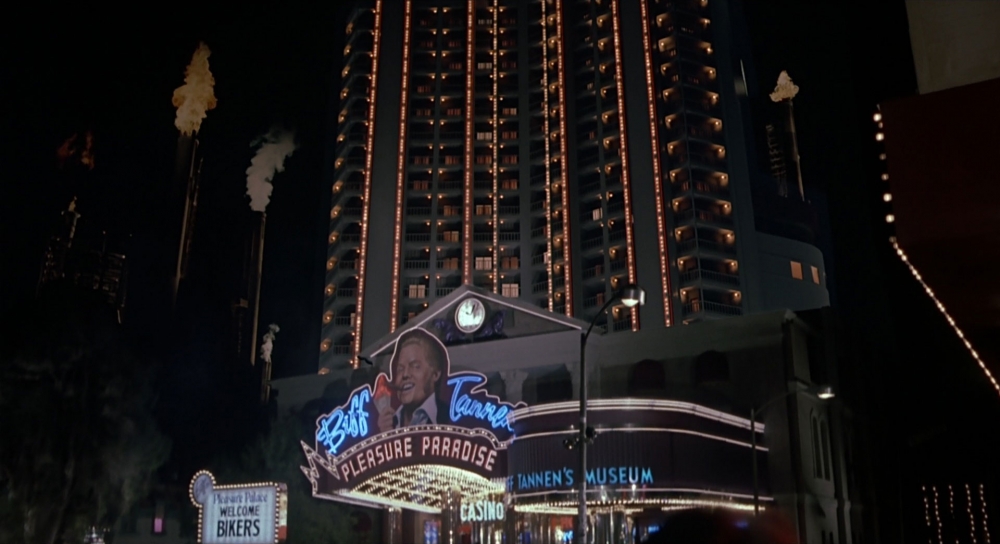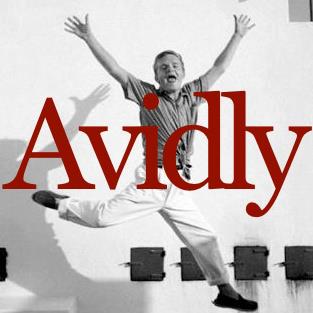Back to the Future premiered on Fourth of July weekend thirty years ago. The essays in this Avidly collection, guest edited by Wendy Lee and Stephen Vider, revisit the movie and its two sequels to reconsider their deeper workings and lasting appeal. Read their introduction.
Back to the Future Part II is so well known for transporting its characters into 2015 that any mention of the film will surely be followed by talk of the hoverboards, flying DeLoreans, and self-lacing Nikes featured in its future Hill Valley. Yet when I first saw the film on VHS at the age of seven, in the summer of 1990, I was captivated less by its glittery 2015 than its re-vision of 1985: Marty and Doc Brown return from 2015 to find themselves lost in an alternate 1985—or “1985A,” as Doc writes on his chalkboard. The very idea of an “alternate timeline” still seems to me the film’s most intriguing turn — for reasons both conceptual and personal.  The tangents and repetitions of Back to the Future provided me with my first instruction in what queer theorists have come to call “queer temporality.” And this was a concept, it turns out, that would matter somewhat urgently to me.
The tangents and repetitions of Back to the Future provided me with my first instruction in what queer theorists have come to call “queer temporality.” And this was a concept, it turns out, that would matter somewhat urgently to me.
As Annamarie Jagose characterizes it, queer temporality is “a mode of inhabiting time that is attentive to the recursive eddies and back-to-the-future loops that often pass undetected or uncherished beneath the official narrations of the linear sequence that is taken to structure normative life.” With Jagose’s resonant phrasing, we can better understand how and why Back to the Future skews “normative life” — the life of high school dates, then marriage, then house buying, then babies, then grandbabies —by skewing normative time. As Doc says, it’s up to him and Marty to “straighten all of this out.” Whereas the correct timeline is “straight,” 1985A is pervaded by queer perversion at every level, from narrative structure to production design.
Though 1985A is ostensibly set in the film’s present — and close to the year it was released — its visual style is closer to the dystopic futures portrayed in earlier movies like Blade Runner (1982) and Brazil (1985), the kind of dark world the movie’s creators pointedly wanted to avoid in their representation of 2015. The 1985A sequence also owes its look to clichéd images of urban decay: bars on windows, graffiti, a black family residing in the McFly residence, chalk outlines, a burned-down school, drive-by shootings, motorcycle gangs, legalized gambling, and refinery flare stacks.
This last image has always been especially resonant for me: I grew up in San Pedro, CA, a section of Los Angeles encircled by oil refineries. The scene in which Marty visits the cemetery looking for his father’s grave — refinery tanks and smokestacks in the background—was filmed in Wilmington, just one town over. For “Hell Valley,” the film’s location scouts sought out and brought out the ugly side of L.A.: specifically what Thom Anderson, in his 2003 documentary Los Angeles Plays Itself, characterizes as the “unglamorous” South Bay where I grew up, a region usually seen only in thrillers like To Live and Die in L.A (1985) or The Usual Suspects (1995).
All this literal and figurative darkness is the obverse of Ronald Reagan’s sunny “Morning in America,” which gets cited in the nostalgic Cafe ’80s that Marty enters in 2015. Given that “family values” discourse originated with the rise of Reaganite politics, it’s no surprise that 1985A offers a nightmarish vision of family decay. Marty discovers that his mother Lorraine is an unhappy alcoholic, with augmented breasts, married to a wealthy and abusive Biff, who murdered Marty’s father George. In 1985A, familial harmony has unraveled; the Law has been usurped by corruption and hedonism as embodied by Biff, who has transformed the Hill Valley Courthouse into “Biff Tannen’s Pleasure Palace.”  In this decadent world, heterosexuality itself gets queered, rendered grotesque in the case of Biff (who canoodles with two women in a jacuzzi) or campy in the case of Lorraine (in an interview on the 25th Anniversary DVD edition, Lea Thompson says she “was basically playing a drag queen,” while co-screenwriter and co-producer Bob Gale claims Tammy Faye Bakker as the inspiration).
In this decadent world, heterosexuality itself gets queered, rendered grotesque in the case of Biff (who canoodles with two women in a jacuzzi) or campy in the case of Lorraine (in an interview on the 25th Anniversary DVD edition, Lea Thompson says she “was basically playing a drag queen,” while co-screenwriter and co-producer Bob Gale claims Tammy Faye Bakker as the inspiration).
The point of dystopia is to present us with a world we shouldn’t want to live in; the point of 1985A’s dystopia, it seems, is to instill the moral conveyed by Reagan’s 1986 Christmas radio address: that “it’s more important than ever for our families to affirm an older and more lasting set of values.” That’s why Doc insists he and Marty “must succeed.” “Success” here means returning (in true Reagan-era fashion) to the 1950s and thereby restoring Marty’s family to the heterosexual happiness it enjoyed at the end of the first film.
We should remember, though, that that 1985 is itself an alternative to the 1985 with which Part I opens. The initial Hill Valley is full of graffiti, alcoholism, and lower-middle-class malaise not unlike Part II’s dystopia. In a 2013 interview, actor Crispin Glover claims he didn’t return to play George McFly in Part II because he “had questions” about how the screenplay for Part I ended by giving the characters a “monetary reward,” implying that “money equals happiness.” Both Part I and Part III end with this moral: George is a successful author, Lorraine a fit and radiant housewife, Biff a milquetoast auto detailer, the McFly home a yuppie’s dream house, and Marty a hero who gets both the girl and the car of his dreams.
It’s tempting to view the films’ insistence on yuppie success and family values as conservative (Michael J. Fox’s other iconic role as Alex P. Keaton on Family Ties surely contributes to that temptation). But we shouldn’t forget that Part II also attributes Hell Valley to greed and unregulated capitalism. In 2015, Marty’s covetousness prompts him to buy a sports almanac. The elderly Biff steals it, along with the DeLorean, traveling back to 1955, where he gives the almanac to his younger self, who will, in turn, exploit it to amass a fortune first in gambling wins and then in nuclear power and toxic waste disposal. Made in the wake of 1987’s Black Monday crash, Part II seems less willing than its predecessor—though not entirely unwilling—to endorse the values of the Me Decade. Its sometimes campy, sometimes dark excesses open some space to critique the heteronormative and capitalist values taken for granted elsewhere in the trilogy.
No one would cherish the dark world of 1985A. But the mere notion that time can split open, unleashing “undetected and uncherished” alternatives and possibilities, may be inevitably thrilling—perhaps for a protogay child in particular. It is that lesson that keeps bringing me back to Back to the Future and that forms my desire to return, like Biff revisiting his younger self, to the queer seven-year-old whose attention it first captured.
Corey McEleney: Doesn’t Need Roads

